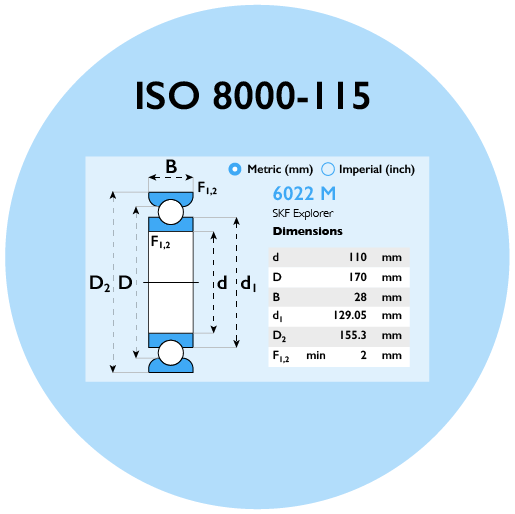Insyte and Resources
ISO 8000 data quality identifiers explained for the smart supply chain
My fellow ISO committee member, Justin Magruder, the MD of Noetic Partners, and former Chief Data Officer, Vice President, Enterprise Information Strategy and Management at Freddie Mac, has been a prime mover for these parts of the standard. You can find his specific take on ISO 8000-116 here.
My focus in this article, however, is how quality identifiers for products and entities can enable the smart supply chain. There are many smart manufacturing initiatives such as Industrie 4.0 (i40) who rely on digital data, and increasingly on a smart supply chain or Logistics 4.0.
Identifiers are used in our everyday lives, examples of identifiers include: vehicle registration number (license plate), Vehicle Identification Number (VIN), driver’s permit number, social security number, national identity card number, student number, employee number, passport number, tax identification number, IP address, telephone number, email address, domain name, part number, batch number, serial number, customer number, supplier number, most things you can think of have an identifier of some sort as a shortcut to more comprehensive data.
The international standard ISO 8000-115 introduced in early 2018, makes a significant contribution to enabling more efficient data exchange, by setting out the syntactic, semantic and resolution requirements. Whilst identifiers are initially designed to be used internally within a system that belongs to an organization, frequently those organizations exchange identifiers with external parties, and this is especially true when it comes to system interoperability. These identifiers become aliases for data that is controlled and managed by the owner of the identifier. By definition, ISO 8000-115 identifiers resolve to an ISO 8000-110 compliant data set. Now, with ISO 8000-115 you know whose part number that is, and as we describe below, with ISO 8000-116 and the ALEI you know the true identity of the entity you are dealing with.
Verifying and validating the quality of master data depends on an ability to identify the owner of data. If the part number is not preceded by the identification of the owner of the data, then the data becomes very difficult to resolve. As illustrated with the RBS example, when dealing with millions of trades this is a major issue. This verification and validation also requires an ability to resolve identifiers to the data sets that they identify.
Manufacturers own the data for the products they produce. In any data exchange, they are the suppliers of the data, in the same way that they are the suppliers of the product. It has not always been apparent to manufacturers the crucial role they play in the data exchange supply chain.

New standards driving clear identification of items
Quality identifiers
Published in April 2018, this new standard enables clear identification of an individual manufacturers specification by the addition of a prefix, owned by, and clearlly identifying, the owner of the item:
- Prefix – SKF
- Identifier – 6022 M
- Becomes SKF-6022 M
An ISO 8000-115 prefix resolves to an ISO 8000-110 compliant catalogue item
“Your organization must have a D-U-N-S Number so that we can verify your organization’s identity and legal entity status. Your D-U-N-S Number will be used to check the identity and legal entity status of your organization as part of our enrolment verification process for joining the Apple Developer Program or the Apple Developer Enterprise Program. While many types of businesses can receive a D-U-N-S Number, your business must be recognized as a legal entity (e.g., a corporation, limited partnership, limited liability company) to enter into the legal terms and obligations of Apple Developer Program agreements. DBAs, fictitious businesses, trade names, and branches are not accepted. Companies and educational institutions must provide a D-U-N-S Number registered to their legal entity, while a D-U-N-S Number is optional for government organizations”.
The D-U-N-S Number is copyright, and is a proxy identifier, and by a proxy we mean that the D-U-N-S Number is issued by an organization (D-U-N-S) that is not the administrative agency that granted legal status to the entity that D-U-N-S are identifying. ISO 8000-116 allows for the creation of an Authoritative Legal Entity Identifier (ALEI) that will make it easier for the supply chain to reliably obtain the legal name, date of formation, the status of trading partners, and the service address, directly from the administrative agency for a government that granted the legal status. The standard utilises the widely used codes from ISO 3166 to define the country and subdivision that the entity is registered in.
ECCMA, the e-Commerce Code Management Association has created an excellent site where companies can register their ALEI, and others can resolve an ALEI.
A good feature of using these two new standards is their ability to work together, the prefix element of ISO 8000-115 identifier is tied to the ISO 8000-116 record ensuring that you know “who owns” the prefix. This is another step in proving the provenance of data sets.
ALEI – The authoritative Legal Entity Identifier is defined in ISO 8000-116
Example
- MRO Insyte Limited is a registered company in the UK region of England and Wales (GB-EAW)
- The Corporate Register is maintained by Companies House (CT)
- MRO Insyte registration number is 06236771
- The ALEI for MRO Insyte is therefore: UK-EAW.CR:06236771
Digital data, such as data that complies with ISO 8000 has the ability to transform the current methods of exchanging data between organizations. You can read more about ISO 8000 digital data on the digital data page on the MRO Insyte website. and in articles such as Creating your own Catalogue Item.
About the author

Peter Eales
Chief Executive MRO Insyte
Peter Eales is a subject matter expert on MRO (maintenance, repair, and operations) material management and industrial data quality. Peter is an experienced consultant, trainer, writer, and speaker on these subjects. Peter is recognised by BSI and ISO as an expert in the subject of industrial data. Peter is a member ISO/TC 184/SC 4/WG 13, the ISO standards development committee that develops standards for industrial data and industrial interfaces, ISO 8000, ISO 29002, and ISO 22745, and is also a committee member of ISO/TC 184/WG 6 that is developing the standard for Oil and Gas Interoperability, ISO 18101.
Peter has previously held positions as the global technical authority for materials management at a global EPC, and as the global subject matter expert for master data at a major oil and gas owner/operator. Peter is currently chief executive of MRO Insyte, and chairman of KOIOS Master Data.
Peter also acts as a consultant for ECCMA, and is a member of the examination board for the ECCMA ISO 8000 MDQM certification.
ECCMA is a membership organization and is the project leader for ISO 22745 and ISO 8000 KOIOS Master Data is a world leading cloud MDM solution enabling ISO 8000 compliant data exchange MRO Insyte is an MRO consultancy advising organizations in all aspects of materials management
